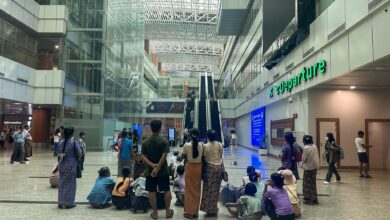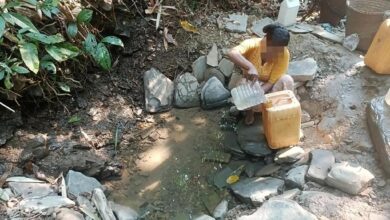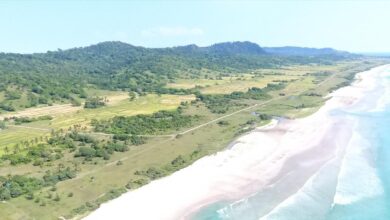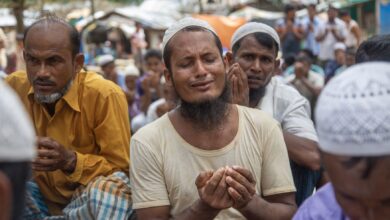
On February 1, the second anniversary of the coup that stole his generation’s future, 18-year-old Khant Thiha was on the battlefield near Bone Bwet, a village about 10km south of the Sagaing Region city of Shwebo.
He had been in the area for nearly a year by this time. A native of Yangon, he had come to Sagaing in April of last year after the military tightened its grip on Myanmar’s largest city and arrested a number of his friends in the resistance.
Now he was a member of the Black Wolf People’s Defence Force (PDF), a local armed group that welcomed him into its ranks. But as in Yangon, he had no intention of shooting to kill. His “weapon” was not a gun but a camera, and his mission was to document the revolution being fought by tens of thousands of others like him around the country.
This day’s clashes would not be like the many others he had witnessed, however. As he was following his comrades with his camera, he was hit by shrapnel from an artillery shell that exploded nearby. It shattered one of his legs and inflicted other heavy injuries.
He gripped his camera tightly as he was carried away on a stretcher. According to a friend who was with him at the time, he also began singing a revolutionary song, defying both the agonising pain that he was in and the regime that had caused his country so much suffering.
“He would not let go of his camera the whole way to the hospital. He held it like he was still shooting something. I could see his defiant spirit in that moment. ‘I am still shooting, I will never give up’—that kind of spirit,” the friend of the wounded youth said.
But Khant Thiha—known to many as “Spiderman” because of the mask he often wore at rallies in Yangon to disguise his identity—did not survive his injuries. He died later that day, along with two other members of the Black Wolf PDF.
Photographers under fire
As the chief contributor to the Nway Oo Photography Facebook page, Khant Thiha had shared many images of the junta’s atrocities in Sagaing, which over the past two years has borne the brunt of its attacks on resistance strongholds.
From the start of the anti-coup movement, photographers have played an important role in keeping the country, and the rest of the world, informed about the situation on the ground, both in Myanmar’s cities and in its more remote regions. For this reason, they have often been vulnerable to attack.

Among the first photographers to die at the hands of the regime was Soe Naing, a freelance photojournalist who was arrested in Yangon’s Latha Township on December 10, 2021, while taking photos of the anti-coup Silent Strike held on that day. His family was informed of his death in custody days later, but was never allowed to claim his body.
More recently, junta forces arrested another photographer at his home in Mandalay. Aung Win Htut was beaten in front of his family before being taken away for questioning on the evening of February 19. Three hours later, regime authorities contacted his family to tell them that his arrest had been a “mistake.” But by then, he was already dead.
Only a handful of photographers, however, have deliberately put themselves in harm’s way to capture images of the struggle against military rule. This is what Khant Thiha decided to do after witnessing the regime’s brutal crackdowns on peaceful anti-coup demonstrations in Yangon.
As more and more protesters were savagely beaten or shot in the head by snipers, many fled to border areas under the control of ethnic armed groups to join the burgeoning resistance movement. Khant Thiha eventually did the same, but not before spending more than a year in Yangon documenting “flash mob” protests throughout the city.

Wearing his Spiderman mask and armed only with a cheap smartphone, he filmed and photographed these fleeting gatherings to show the outside world that the coup was still strongly opposed by Myanmar’s citizens. His images were used by foreign news agencies and were a testament to the spirit of defiance that he shared with so many others of his generation.
But after seven of his closest friends were arrested and his own home was raided in March of last year, he decided it was finally time to leave Yangon. And so he headed for Sagaing.
“He said he couldn’t risk an arrest, because it would mean that he wouldn’t be able to resist the junta anymore. He wanted to keep fighting by other means, so he went to Sagaing,” his girlfriend Hnin recalled.
About a month later, Hnin joined him there. By this time, he was already doing what he did best—following his comrades and photographing them in action. He also took photos of the scenes of devastation that junta troops left behind as they rampaged through village after village.
“He often said he wanted to open a gallery to exhibit his photographs, after the revolution. He said he would use the proceeds to help the displaced people,” said Hnin.
But Khant Thiha did not live to see that day.
“He wanted to go so bad,” Hnin recalled of her boyfriend’s final mission. “He yelled, ‘Captain, I will join them!’ as he hopped into the car. It was his last day,” she said, choking up as she spoke.

‘It traumatised me’
When the military seized power two years ago, Myo Htet Hla Thaw, 27, and his twin Myo Satt Hla Thaw were already experienced photographers and veterans of the struggle against military oppression. In 2015, the two brothers from Bago, who were both members of the All Burma Federation of Student Unions, took part in protests to demand changes to the National Education Law. The ensuing crackdown, which shocked many at a time when Myanmar was supposedly moving away from military rule, prepared them well for the brutality they were to witness six years later.

Myo Htet Hla Thaw was working as a photojournalist for a news agency in Yangon when the army decided to abruptly reverse the reforms of the previous decade on February 1, 2021. Soon after the coup, he quit that job to become a freelancer. For three months, he took photos of the protests in Yangon and Bago, where he saw junta troops firing on unarmed civilians with live ammunition.
“A woman collapsed in front of me after inhaling tear gas. Some young protesters with shields and I tried to grab her, and suddenly bullets started flying past, hitting the wall next to us,” he recalled.

As the junta strengthened its hold over Yangon, he left for Karen (Kayin) State to begin his long journey through Myanmar’s war zones. He shot photos and video of fighting and its aftermath in some of the country’s worst conflict hotspots, including Pale, Kani, Salingyi, Yinmarbin, Kanbalu, Katha, Tigyaing and Kyunhla townships in Sagaing Region and Pakokku and Myaing townships in Magway. Since November of last year, he has been in northern Shan State.

Throughout his travels, he has photographed young resistance fighters, some carrying automatic rifles and others armed only with handmade guns. He has also captured images of a landscape scarred by war: huge holes left behind by landmine explosions and charred fields full of rubble where villages once stood.
His brother Myo Satt Hla Thaw has followed a similar path. He was working for Myanmar Now at the time of the coup, but soon resigned as the regime stepped up its efforts to eliminate independent media outlets.

On February 28, four weeks after the coup, Myo Satt Hla Thaw was photographing a protest at Hledan junction in Yangon’s Kamaryut Township when he saw a young man get shot in the stomach. His photo of the man, who bled to death from his wounds, received worldwide attention. But for the photographer himself, this was far more than just another dramatic image.
“I saw it happen right before my eyes. It traumatised me,” said Myo Satt Hla Thaw, who left Yangon soon after this incident.
Many of his friends and colleagues had already fled the country by this time, and they urged him to join them. But he wanted to experience the revolution, so he went to Karenni (Kayah) State, which was rapidly becoming a major front in the fight against military rule.
From the jungles of the Thai-Myanmar border, he was able to take photographs that told the stories of those who fought the regime and those whose lives had been destroyed by the junta’s relentless attacks. He wanted to record their suffering, not just to appeal to the outside world for support, but also to hold those responsible to account.

“I recorded many things so that they could be used as evidence in seeking justice or to inform the international community in the future,” he said, adding that he has built up an archive of photos that he has not yet shared with anybody.
Making the world understand
Some photos, however, demand to be seen.
In late March, 28-year-old Karenni photographer Mauk Kham Wah was named the winner of a World Press Photo regional award for a photo that he took in southern Shan State the year before. Titled “Retrieving the Dead,” it shows a Karenni resistance fighter carrying a blood-soaked fallen comrade over his shoulder after a day of fierce fighting south of the town of Moebye, near the border with Karenni State.

At least 15 members of various allied anti-regime forces were killed that day in February 2022. Many were from a group that had gathered around one of their number as he was being treated for wounds on the battlefield. As they stood there, a 120mm artillery shell suddenly landed right on top of them.
Mauk Kham Wah was with several other resistance fighters just a few feet away when the shell exploded. He saw everything.
“Some were hit in the face, and some had their heads torn off their shoulders. Some got shrapnel in their eyes, while others had their legs and hands shattered,” he recalled.
Shocked by what he saw, Mauk Kham Wah felt the energy drain out of his body, until he was able to remind himself what he was there for.
“I have never in my life lacked the strength to press the camera’s shutter button, but in that moment, I really had to force myself to take pictures,” he said.

The body in Mauk Kham Wah’s award-winning photograph was that of Myat Min Khant, a 23-year-old medic who belonged to the Loikaw chapter of the PDF. Loikaw, the capital of Karenni State, is also Mauk Kham Wah’s hometown.
Working as a Yangon-based filmmaker until the coup, he returned to his native state a few months after the military seized power to document the war that was taking shape there. Acutely aware of how little the rest of the world knows about the struggle in his homeland, he was determined to portray it in terms that others might understand.
“Karenni State is just a small dot compared to our earth. But living in that small dot are those who are fighting injustice with their lives. I wanted to speak out about them,” he said in a recent interview with Myanmar Now.
It appears that he has succeeded in his mission. Explaining its decision to recognise Mauk Kham Wah’s photo, the World Press Photo’s jury said the image conveyed “the solemnity of defeat” and the dignity of the dead resistance fighter.
“The image is a universal reminder of the state of the world wherein people are forced to put their lives on the line to fight for something they believe in,” said the jury when the award winners were announced.
Now acting as the information officer for the Loikaw PDF, Mauk Kham Wah makes no apology for being a photographer who is also an active member of the resistance. Nor does he make any distinction between his role and that of those who fight with other weapons.
“I hit my camera’s shutter, while my comrades pull triggers. They do their job and I take photos of them. That is my job,” he said.
“I have to follow them when they retreat. When they make advances, I have to do the same. When they go into a minefield, I have to go with them. I can’t turn back halfway, even when I feel afraid.”
Additional reporting by Esther J.



